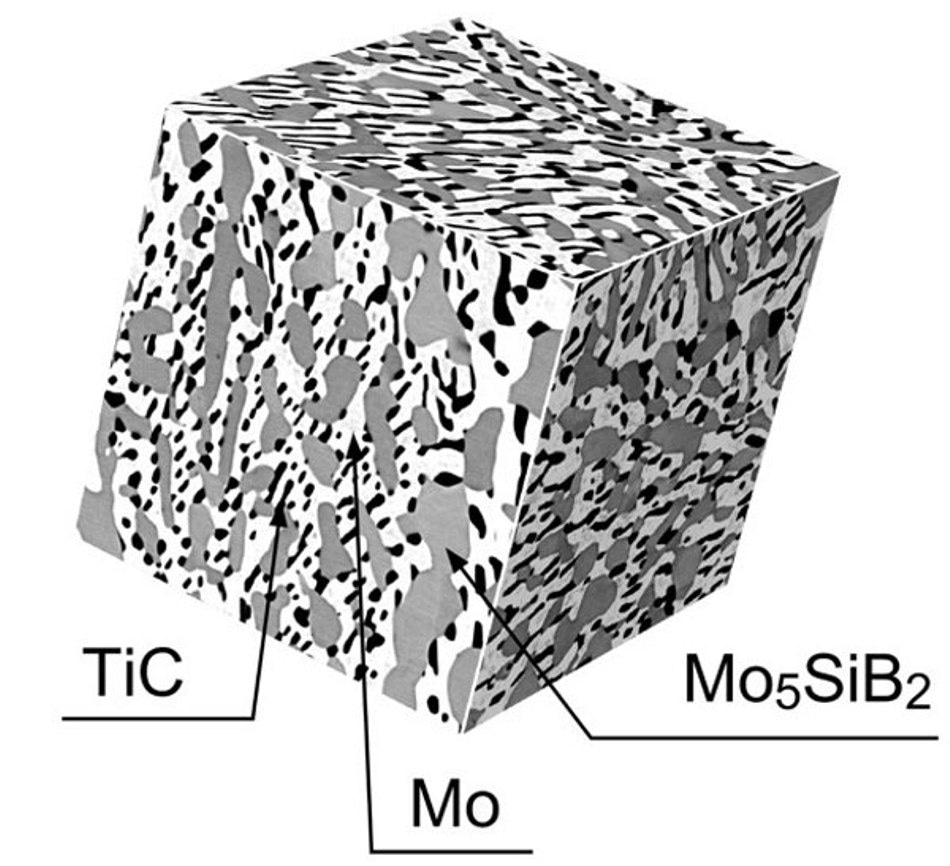Sep 28 2018
Japanese researchers have identified a metal that has the ability to endure constant forces at ultrahigh temperatures, providing promising applications such as in gas turbines for electric power generation and in aircraft jet engines.
 3D SEM Microstructure of 1st Generation MoSiBTiC alloy. (Image credit: Kyosuke Yoshimi)
3D SEM Microstructure of 1st Generation MoSiBTiC alloy. (Image credit: Kyosuke Yoshimi)
The first-of-its-kind research, reported in Nature’s open access journal Scientific Reports in July 2018, gives a detailed account of a titanium carbide (TiC)-reinforced, molybdenum-silicon-boron (Mo-Si-B)-based alloy, or MoSiBTiC, whose high-temperature strength was recognized under constant forces in the temperature ranges of 1400 to 1600 °C.
“Our experiments show that the MoSiBTiC alloy is extremely strong compared with cutting-edge Nickel-based single crystal superalloys, which are commonly used in hot sections of heat engines such as jet engines of aircrafts and gas turbines for electric power generation,” stated lead author Professor Kyosuke Yoshimi of Tohoku University’s Graduate School of Engineering.
“This work suggests that the MoSiBTiC, as ultrahigh temperature materials beyond Nickel-based superalloys, is one promising candidate for those applications,” added Yoshimi.
Yoshimi and team have reported various parameters that underscore the beneficial ability of the alloy to endure disruptive forces under ultrahigh temperatures without being deformed. They also studied the behavior of the alloy upon being exposed to increasing forces and when cavities within MoSiBTiC formed and grew, leading to microcracks and final rupturing.
The performance of heat engines is vital to the harvest of energy in the future from fossil fuel and the subsequent transformation to electric power and propulsion force. The improvement of their functionality might ascertain their efficiency in energy conversion. Creep behavior—that is, the ability of the material to endure forces under ultrahigh temperatures—is a significant factor as increased temperatures and pressures result in creep deformation. Gaining insights into the material’s creep can assist engineers in developing efficient heat engines with the ability to withstand the extreme temperature environments.
The scientists evaluated the alloy’s creep in a stress range of 100–300 MPa for 400 hours. (MPa, or megapascal, is a unit used to measure extremely high pressure and is equal to roughly 145 psi, or pound per square inch.)
All experiments were carried out using a computer-controlled test rig under vacuum to prevent oxidization of the material, or reaction with any potential air moisture, which could eventually lead to rust formation.
Moreover, it has been reported in the study that, in contrast to earlier studies, the alloy undergoes larger elongation with decreasing forces. This behavior, the authors describe, has so far been noticed only in superplastic materials that have the ability to withstand against unanticipated, premature failure.
These outcomes are a significant indicator for MoSiBTiC’s usability in systems that operate at exceptionally high temperatures, such as energy conversion systems in power plants and automotive applications, and propulsion systems in aircraft engines and rockets. The scientists report that a number of additional microstructural analyses are required to gain complete insights into the alloy’s mechanics and its potential to recover from exposure to high stresses such as large forces under high temperatures.
They expect to constantly refine their outcomes in their future studies. “Our ultimate goal is to invent a novel ultrahigh temperature material superior to Nickel-based superalloys and replace high-pressure turbine blades made of Nickel-based superalloys with new turbine blades of our ultrahigh temperature material,” stated Yoshimi. “To go there, as the next step, the oxidation resistance of the MoSiBTiC must be improved by alloy design without deteriorating its excellent mechanical properties. But it is really challenging!”
The research was supported by the Advanced Low Carbon Technology Research and Development Program (ALCA) of the Japan Science and Technology (JST) (No. JPMJAL1303) as well as the Japanese Society for Promotion of Science (JSPS).